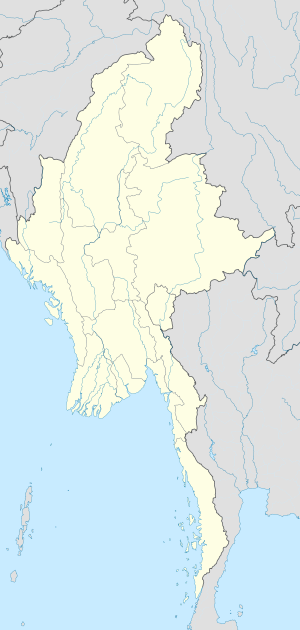Shwemawdaw Pagoda
| Shwemawdaw Pagoda | |
|---|---|
 |
|
| Basic information | |
| Location | Bago |
| Geographic coordinates | 17°20′13″N 96°29′49″E / 17.3368744°N 96.496954°ECoordinates: 17°20′13″N 96°29′49″E / 17.3368744°N 96.496954°E |
| Affiliation | Theravada Buddhism |
| Country | Myanmar |
| Completed | 10th century |
The Shwemawdaw Pagoda (Burmese: ရွှေမောဓော ဘုရား [ʃwè mɔ̀dɔ́ pʰəjá]; Mon: ကျာ်မုဟ်တ [tɕaɪʔmṵtú]) is a stupa located in Bago, Myanmar. It is often referred to as the Golden God Temple. At 375 feet (114 m) in height, the Shwemadaw holds the record for the tallest pagoda in the country although the Shwedagon Pagoda in Yangon is usually credited as the tallest pagoda in Myanmar (at 98 metres (322 ft)). Shwemadaw, along with the Shwedagon and Kyaiktiyo, are famous Mon pagodas. The pagoda's annual festival is a 10-day affair that takes place during the Burmese month of Tagu.
The Shwemawdaw Paya was originally built around the 10th century, C.E. It was destroyed several times due to earthquakes, including one in 1917 and another in 1930. Portions of the fallen pre-1917 version of the Paya remain at the site. The original version of the pagoda was approximately 70 feet (21 m) tall, built by the Mon supposedly to hold two hairs of the Buddha. Allegedly, the hairs were given personally to two Mon merchants named Mahasala and Kullasala by the Buddha on a trip to India. Tooth relics were also added to the pagoda in 982 and 1385. Further additions to the temple include a bell from King Dhammazedi, a crown from King Bayinnaung, and a spire umbrella from King Bodawpaya. The current stupa, as of its most recent rebuilding, stands at 375 feet, making it the tallest in Myanmar.
...
Wikipedia

